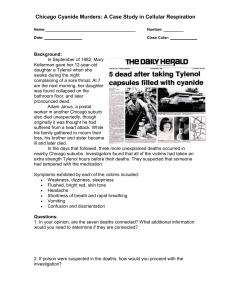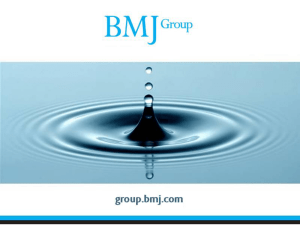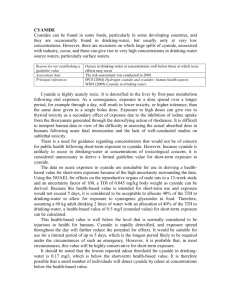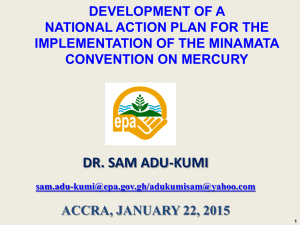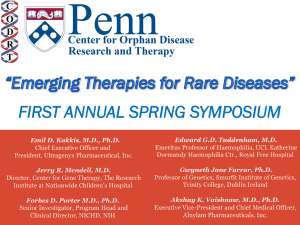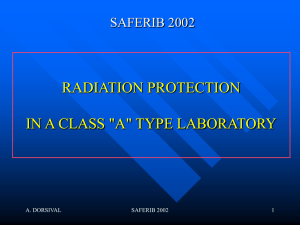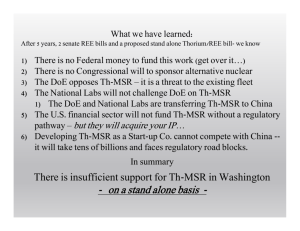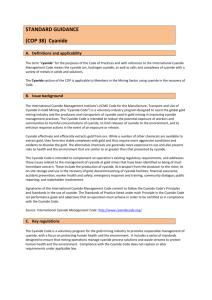从稀土和山埃冶金看环境问题与民运Civil Movements and
advertisement
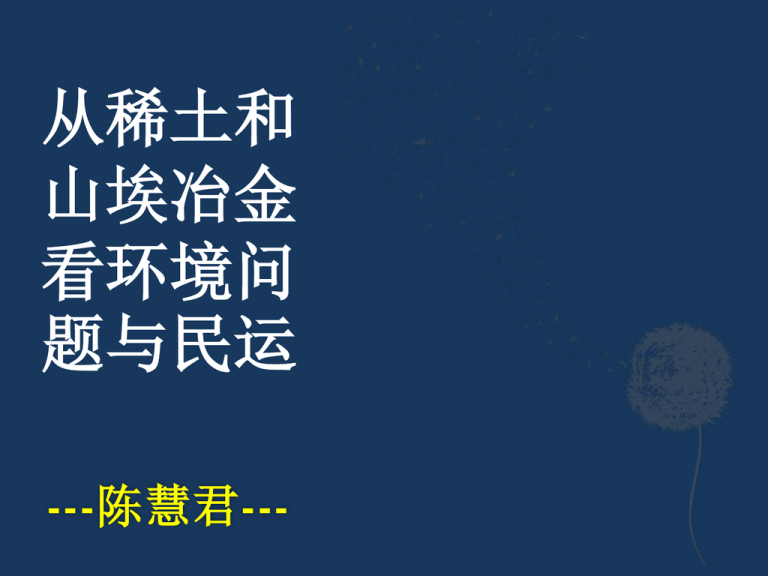
从稀土和 山埃冶金 看环境问 题与民运 ---陈慧君--- 从稀土/山埃采金看环境问题 什么是稀土? Lynas的2008年环境评估报告 山埃采金术/ 稀土冶炼、分离和生产的影响 生态环境 生命安全 水源污染 废料处理 水资源 个案分享 Minamata Dicease 亚洲稀土厂 什么是稀土/ Rare Earth (Lathanides ) ? 包括镧、铈、镨、钕、钇等的十七种金属元素。 稀土的用途与重要性? 绿色能源 / 环保新能源设备(hybrid cars, catalytic converters, wind turbines, next generation thin-film solar cells and energy saving opto-electronics such as LED lighting and flat screen displays) 高科技工业 (各种科技产品、手机电子 电脑产品、汽车及军工行 业高科技产品 所需关键原材料) 20-30kg of rare earth per Toyota hybrid car A 3-megawatt wind turbine contain some two tons of rare earth. ~~300 ton of soil produce 1 ton of rare earth ore 9 什么是山埃? 氰化物,Cyanide,化学式CN 少量的山埃不会对环境和人体造成伤害 人体能自然的排出少量的山埃毒 山埃其实是一种剧毒。根据资料,吸入 300mg/m3的山埃能令人在10分钟内死亡, 口服相等于一颗米的山埃即可引起猝死, 没有药治。 二战时德国纳粹也曾使用这种化学物毒 杀集中营里的囚犯。 什么是山埃采金术? 用剧毒化学物质山埃提炼黄金的提炼法,能提炼出97%的 黄金。 劳勿澳洲金矿公司采用的碳提炼法 (Knelson Concentrator & Carbon-In-Leach Gold Recovery),其基本操作是 1. 2. 3. 4. 5. 6. 把矿石浸入含有山埃液体(Sodium Cyanide + Water) 的大槽中溶 解 接着把含有黄金的液体导入好几个排列的大槽,然后添入碳 ((Carbon),以让黄金吸附在碳的表层 机器将把碳筛离黄金 把附有黄金的碳导入一个含滚烫的山埃液体(sodium hydroxidecyanide-water solution)中溶解 这个高浓度的液体接着将被导经一排电解沉积体(lectrowinning cells) 只需几分钟,黄金液体就会化作片片黄金。 RAGM的山埃废料处理 根据1996年前的环境评估报告 计划把石渣存放在预先挖好的深坑里 待深坑里的石渣存量已达两百万吨时,将把其 余的石渣存放在第一个石渣坑里或空地上。 此处理方法可能无法保护地面和地下水 雨水将冲蚀这些废料 深坑里没有防地下水污染的措施 将把石渣存放区的废水输入矿湖,没有完整的去毒处 理 地下水可能将会被Arsenic, Mercury, Cadnium, Lead (原有矿石里的重金属)和 Cyanide污染 RAGM的山埃废料处理 根据 1996 RAGM 环境评估报告和 2005 Peninsular Gold Ltd 招股说明书 废料与废水没有完整的去毒制程 (detoxification process) “…informed by Peninsular that cyanide destruction is not required by either the local authority, or the lender. Provision has been made in the capital cost for a detoxification plant, although its operating cost has not been included as it may not be required”. (Imprima de Bussy, 2005) 废气与灰尘 Hydrogen Cyanide Release of other contaminant from the CIL and Destruction of Cyanide in Effluent processes Mineral Dust Acidic Drainage 22/4/2011 19:00 环境评估报告 (Environmental Impact Assessment) Only release the Abstract / Executive Summary Full Report ? Quantitative Risk Assessment? Radiological Impact Assessment? Use 121,036ton of rare earth concentrate per year Produce 10,500 ton of Lanthanium Oxide that consist of 6 main products Radioactive waste will be stored in the Tailing Storage Facility till permanent waste disposal facility is establish SO2 will be released from the process No detail EMP and ERP Activities required DEIA Raw material content 1600ppm thorium , 6.7 Bq/gram Waste / Residue Gypsum石膏 Gypsum by Product石膏副产品 Iron Phosphor Gypsum by product铁磷石膏– contain radioactive materia; 6.2 Bg Lynas正在研究把铁磷石膏开发成防护堤与分波器, 唯至今还在研发阶段。因此,这段期间,这些剩余 物将被储存在一个8公尺高的储存槽里, Lynas 有10年 的辐射废料储存期 。 提炼后的成品将运往日本、美国、EU 环境影响 Environmental Impact -三废 在稀土的冶炼、分离和生产的过程中会附带产生大 量的废气、废水和废渣 辐射性尘埃,提炼后的废料中也存留辐射,能通过 空气和水进入人体,导致免疫系统疾病和癌症。 废气 - 粉尘、灼烧、冶炼产生的废气(fluorine and sulful)、酸碱或有机试剂挥发的气体 (VOC) 废水 - excessive acid and radioactive materials 废渣 - Radioactive Thorium can cause cancers of the lung, pancreas and blood, as lungs and other internal organs can be penetrated by alpha radiation. Exposure to thorium internally leads to increased risk of liver diseases. 法令 Government regulation Water Consumption?每小时500立方米 Waste Water (Ammonia, Acid) Air Ionised radioactive Waste Monitoring Water quality 30 parameters include radioactive material? 环境公害与 公民运动 Minamata Disease (水俣病) Wastewater discharge from the Chisso factory in Minamata The crippled hand of a Minamata disease victim Over 3,000 victims have been recognized as having “Minamata Disease“ (confirm in 1959). It has taken some of these people over thirty years to receive compensation for this inconceivable event. From 1932 to 1968, Chisso Corporation, a company located in Kumamoto Japan, dumped an estimated 27 tons of mercury compounds into Minamata Bay. The company believed that it was much cheaper to pay off the few people who were opposed to the dumping, rather than implement an environmentally safe technique of waste removal. Victims were diagnosed as having a degeneration of their nervous systems. Numbness occurred in their limbs and lips. Their speech became slurred, and their vision constricted. Some people had serious brain damage, while others lapsed into unconsciousness or suffered from involuntary movements. As of March 2001, 2,265 victims had been officially recognised (1,784 of whom had died) and over 10,000 had received financial compensation from Chisso. By 2004, Chisso Corporation had paid $86 million in compensation, and in the same year was ordered to clean up its contamination. On March 29, 2010, a settlement was reached to compensate as-yet uncertified victims. 亚洲稀土厂 (ARE) 1982年日本三菱公司的亚洲稀土厂 (Asia Rare Earth)在霹靂红坭山 (Bukit Merah)并引发的一系列脑癌、 白血病、流產、夭折的病发案例, 檳城消费人协会当年的统计显示,埋毒 之间离奇死亡者有3名;因为辐射患上 血癌的儿童共有8名,倖存者仅有两位; 先天脑残者5名,活下只有两位,孕妇 流產、婴儿夭折的比率也是全国的三倍。 亚洲稀土厂 (ARE) 三菱提炼厂最终于1992年关闭。 如今当地已成为亚洲最大辐射废料库之 一。 RM303 million (三亿马币)的废料治理 费用。 300 年的检验、监督和储存, 由霹雳政府 买单。 世界人权宣言 第三条 人 人 有 权 享 有 生 命、 自 由 和 人 身 安 全。


